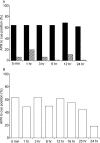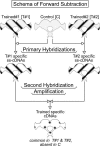Memory consolidation and gene expression in Periplaneta americana
- PMID: 15647592
- PMCID: PMC548493
- DOI: 10.1101/lm.87905
Memory consolidation and gene expression in Periplaneta americana
Erratum in
- Learn Mem. 2005 Mar-Apr;12(2):209
Abstract
A unique behavioral paradigm has been developed for Periplaneta americana that assesses the timing and success of memory consolidation leading to long-term memory of visual-olfactory associations. The brains of trained and control animals, removed at the critical consolidation period, were screened by two-directional suppression subtractive hybridization. Screens identified neurobiologically relevant as well as novel genes that are differentially expressed at the consolidation phase of memory. The differential expression of six transcripts was confirmed with real-time RT-PCR experiments. There are mitochondrial DNA encoded transcripts among the up-regulated ones (COX, ATPase6). One of the confirmed down-regulated transcripts is RNA polymerase II largest subunit. The mitochondrial genes are of particular interest because mitochondria represent autonomous DNA at synapses. These transcripts will be used as one of several tools in the identification of neuronal circuits, such as in the mushroom bodies, that are implicated in memory consolidation.
Figures








References
-
- Adams, M.D., Celniker, S.E., Holt, R.A., Evans, C.A., Gocayne, J.D., Amanatides, P.G., Scherer, S.E., Li, P.W., Hoskins, R.A., Galle, R.F., et al. 2000. The genome sequence of Drosophila melanogaster. Science 287: 2185-2195. - PubMed
-
- Agin, V., Chicher, R., and Chichery, M.P. 2001. Effects of learning on cytochrome oxidase activity in cuttlefish brain. Neuroreport 12: 113-116. - PubMed
-
- Alberini, C.M. 1999. Genes to remember. J. Exp. Biol. 202: 2887-2891. - PubMed
-
- Alkon, D.L. 1984. Calcium-mediated reduction of ionic currents: A biophysical memory trace. Science 226: 1037-1045. - PubMed
-
- Anderson, S., Bankier, A.T., Barrell, B.G., de Bruijn, M.H., Coulson, A.R., Drouin, J., Eperon, I.C., Nierlich, D.P., Roe, B.A., Sanger, F., et al. 1981. Sequence and organization of the human mitochondrial genome. Nature 290: 457-465. - PubMed
Publication types
MeSH terms
Substances
LinkOut - more resources
Full Text Sources
Other Literature Sources
Medical
